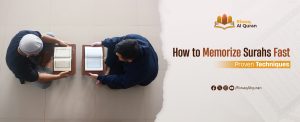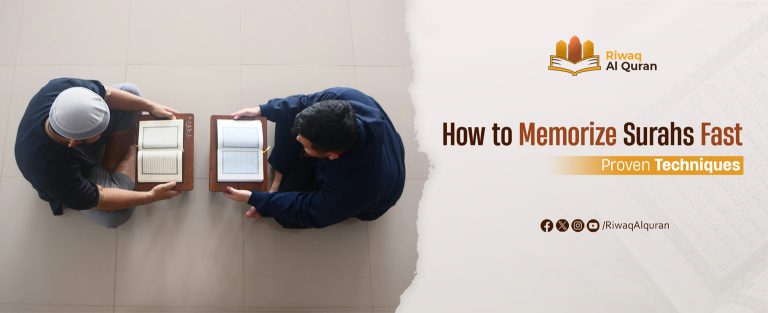In Tajweed (the art of Quranic recitation), Sifaat Al Huroof refers to the inherent characteristics or attributes of the Arabic letters. These attributes are essential for pronouncing each Arabic letter correctly from its precise point of articulation (Makhraj). This science is vital in Tajweed, allowing every generation to recite the Quran exactly as it was revealed, with purity, power, and profound reverence.
In this article, we will discuss what is meant by Sifaat Al Huroof in Tajweed. Then, we will move to the important point: the types of Sifaat Al Huroof. After that, we will tackle the Sifaat of Arabic letters with an example. Then, we will see the difference between Makhraj Huruf and Sifaat Al Huroof and discuss how to identify Sifaat Al Huroof. Finally, we will see the importance of learning this topic.
Table of Contents
What Is Sifaat Al Huroof In Tajweed?
In essence, Sifaat Al Huroof is the sophisticated science that gives each Arabic letter its unique acoustic fingerprint. It is the key to ensuring every word of the Quran is honored with its due right and pronounced with its inherent characteristics.
It ensures every letter is pronounced with its distinct identity. This prevents the confusion of letters that share a point of articulation, thereby safeguarding the meaning of Allah’s words from alteration.
Types Of Sifaat Al Huroof
Now, let’s move to the important point: types of Sifaat Al Huroof. The prominent view is that Sifaat Al Huroof are 17 and they are divided into two main types based on whether they have an opposite or not. Let’s break it down using the following Tajweed Sifaat chart.
1- Contrasting Attributes (صفات متضادة):
These are attributes that exist in pairs of opposites. A letter cannot have both attributes in a pair simultaneously. Below is a breakdown of these 5 pairs.
| Attribute (With Opposite) | Meaning and Effect | Example Letters |
| Hams (الهمس) / Jahr (الجهر) | Whisper (flow of breath) / Voiced (hold of breath) | – Hams (Whisper) letters are ten, which are combined in the following three words:فحثه شخص سكت- Jahr (Voiced) are the remaining 19 Arabic letters, such as:ع – م – ظ – ن -ج |
| Shiddah (الشدة) / Rakhāwah (الرخاوة) / Bayniyyah (البينية) | Strength (stop sound) / Softness (flow of sound) / In-between | – Shiddah (Strength) letters are eight, which are combined in the following three words:أجد قط بكت – Rakhāwah (Softness) letters are 15, along with the Madd Alif. Examples of these are:ح – خ – س – ش – ف- Bayniyyah (In-between) letters are five, which are combined in the following two words:لن عمر |
| Isti’lā’ (الاسْتِعْلاء) / Al-Istifāl (الاسْتِفَال) | Elevation (tongue rises) / Lowering (tongue is flat) | – Isti’lā’ (Elevation) letters are seven, which are combined in the following three words:خص ضغط قظ- Istifāl (Lowering) letters are the remaining 22 Arabic letters, such as:ت – ث – ك – ل |
| Iṭbāq (إطْبَاق) / Infitāh (انْفِتَاح) | Closing (tongue touches palate) / Opening (mouth is open) | – Iṭbāq (Closing) letters are four:ص – ض – ط – ظ- Infitāh (Opening) letters are the remaining 25 Arabic letters, such as:ج – ن – م – ل |
| Ithlāq (إذْلاق) / Ismāt (إصْمَات) | Fluency (easy to pronounce) / Non-fluency | – Ithlāq (Fluency) letters are six, which are combined in the following three words:فر من لب- Ismāt (Non-fluency) letters are the remaining 23 Arabic letters, such as:ت – ق – ص – هـ – س |
2- Non-Contrasting Attributes (صفات غير متضادة):
These attributes do not have a direct opposite. A letter can have more than one of these. For example, as we will see below, the ر letter is both Inhiraf and Takreer letter.
| Attribute | Meaning & Effect | Example Letters |
| Safeer (الصفير) | Whistling sound | – Safeer (Whistling) letters are three: ص – ز – س |
| Qalqalah (القلقلة) | Bouncing sound | – Qalqalah (Bouncing) letters are five, which are combined in the following two words:قطب جد |
| Leen (اللين) | Ease or softness in pronunciation | – Leen (softness) letters are only two:و – يBut they must be Sakin and be preceded by a letter with Fatha (َ).For example, the ي in “خَير” is a Leen letter. |
| Inhiraf (الانحراف) | Deviation of sound | – Inhiraf (Deviation) letters are only two:ل – ر |
| Takreer (التكرير) | Trilling of the tongue | – Takreer (Trilling) letter is one:ر |
| Tafashee (التفشي) | Spreading of air in the mouth | – Tafashee (Spreading of air) letter is one:ش |
| Istitālah (الاستطالة) | Elongation of the sound | – Istitālah (Elongation) letter is one:ض |
Read Also: Huroof Al Muqatta’at In Tajweed
Sifaat Of Arabic Letters
Sifaat (singular: Sifah) are the distinct qualities that define a letter’s sound, giving it a unique identity and preventing it from being confused with another letter that might share a similar Makhraj (point of articulation).
Example:
The Arabic letters ص and س share the same Makhraj [point of articulation], which is the tip of the tongue and the teeth. However, they both have some similar and some different Sifaat that make each of them unique. For example, both س and ص are Hams, Rakhāwah, and Safeer letters. However, س is an Istifāl, Infitāh, and Ismāt letter, while ص is an Isti’lā’ and Iṭbāq letter.


The Difference Between Makharij And Sifaat
To pronounce any Arabic letter correctly, you must know both its Makhraj [point of articulation] and its Sifaat [attributes]. Knowing both the Makhraj and Sifaat of a letter is what gives Arabic its distinct and pure sound, ensuring the Quran is recited exactly as it was revealed.
However, Makhraj and Sifaat of a letter are not the same. Let’s see below how they are different.
Makhraj [Point Of Articulation]:
Makhraj is the point or place where the sound comes from (e.g., lips, throat, tongue). So it is the “where“—the specific location in the human vocal apparatus where the sound of a letter is produced.
Sifaat [Attributes]:
Sifaat refers to the manner in which sound is produced (e.g., heavy/light, whistling, flowing). So it is the “how“—the distinct quality, feature, or effect that gives the letter its unique sound.
Read Also: Makhraj Huruf
How To Identify Sifaat Al Huroof?
Identifying the Sifaat (attributes) of Arabic letters is a skill developed through a combination of theoretical knowledge and practical application. Here is a step-by-step guide on how to do it.
Step 1: Master Makhraj Huruf First:
You cannot accurately identify a letter’s Sifaat (attributes) without first knowing its Makhraj (point of articulation). Many letters share the same Makhraj and are distinguished only by their Sifaat.
Example:
The letters ت, د, and ط all use the tip of the tongue. So the latter is their point of articulation (Makhraj). However, their vastly different sounds come entirely from their attributes (please refer to the above-mentioned Sifaat charts).
Step 2: Learn The Key Contrasting Attributes:
Start with the five contrasting pairs. Identify a letter by asking a series of yes/no questions based on these opposites. You can use the chart of the contrasting attributes above.
Step 3: Identify The Non-Contrasting Attributes:
Once you have placed the letter using the pairs above, check for these unique non-contrasting “special effects”, such as Qalqalah, Leen, etc. For practical examples, please see the non-contrasting attributes chart above.
Step 4: Listen To Qualified Quran Reciters:
You can listen to reciters such as Shaikh Al Hossary and Shaikh Al Minshawy. Pay attention to how they pronounce each letter. You can even get more benefit by looking at these letters from the Quran when listening to the recitation. Then you can repeat after the Shaikh. This way, you will utilize three senses of learning: sight, listening, and speaking.
Importance Of Learning Sifaat Al Huroof
Now, let’s move to the vital question: Why are Sifaat Al Huroof so important to learn? Please see below four of the main reasons for this.
1. Distinguishing Between Letters That Share The Same Point Of Articulation:
Learning Sifaat Al Huroof enables you to differentiate between Arabic letters that have the same Makhraj [point of articulation].
Example:
Both س and ز have the same point of articulation [the tip of the tongue comes very close to the upper teeth, without touching them]. What makes each of them unique is learning their Sifaat (attributes). They share almost all of the attributes except for one. On one hand, the س letter has Hams (flow of breath). On the other hand, the ز letter has Jahr (hold of breath).
2. Preventing incorrect meaning: changing the meaning of words completely:
As we have seen in point number 1, the two words: “الرجز” and “الرجس” have different letters (ز and س) and thus different meanings. The former means “disbelief, associating other gods with Allah, etc.” while the latter means “dirtiness”.
3. Learning about the strong and the weak letters:
Differentiating between the strong and the weak Arabic letters is especially important in the issue of Idgham [a very important topic in Tajweed]. Usually, it is the weaker letter that is being interred into the stronger one.
Example:
“وَدَّت طَّآئِفَةٌۭ…”
Here, the first word ends with a ت letter and the second starts with a ط. Since ت is weaker than ط (according to the attributes of Arabic letters), the ت sound is dropped and the ط is kept. In other words, there must be Idgham of ت in ط sound.
4. Preservation of the Quran:
As we have seen in points 2 and 3, differentiating between how each Arabic letter is pronounced is vital to Tajweed. That’s why Sifaat Al Huroof is considered a vital science that ensures every word of the Quran is transmitted orally exactly as it was received, preserving its meaning and message.


Read Also: Quran Alphabet And Tajweed Letters Pronunciation With Examples
Learn Quran, Arabic And Islamic Studies Online With The Best Native Tutors
Riwaq Al Quran is a comprehensive online platform that offers personalized Quran, Arabic and Islamic Studies Online classes for individuals of all ages and backgrounds.
Their experienced instructors use a structured curriculum to cover Tajweed, Tafsir, and Memorization, providing easy and effective access to learning the Quran.
The advanced online classes allow for seamless communication and interaction between students and teachers. Join Riwaq Al Quran for a deeper connection with the Quran.
We offer several courses such as:
- Online courses for kids.
- Online Quran classes for kids and adults.
- Online Arabic courses
- Online Ijazah courses
- Online Islamic Studies courses.
Here are a sample of our set of Quran Courses that will be helpful for you:
- Online Tafseer Course: Delve into Quranic meanings with our insightful online Tafseer course.
- Noorani Qaida Online: Learn Quranic basics efficiently through our Noorani Qaida online program.
- Online Quran Recitation Course: Enhance Quranic recitation skills through our expert-led online course.
- Online Tajweed Classes: Master Tajweed rules for beautiful Quranic recitation in online classes.
- Quran Memorization Online Course: Memorize the Quran effectively with our specialized online memorization course.
- Online Qirat Course: Explore diverse Qirat styles with our comprehensive online Qirat course.
- Online Quran Classes for Kids: Nurture a love for the Quran in kids through interactive online classes.
Conclusion
In conclusion, the science of Sifaat Al Huroof (Attributes of the Letters) is not merely a set of phonetic rules but the very heart of Tajweed and the preservation of the Quran. It moves the reciter beyond simply knowing where a letter originates (Makhraj) to mastering how it should sound—its character, strength, and essence. Mastery of this science is a lifelong pursuit for every serious student of the Quran. Let this be an invitation to join their ranks.































